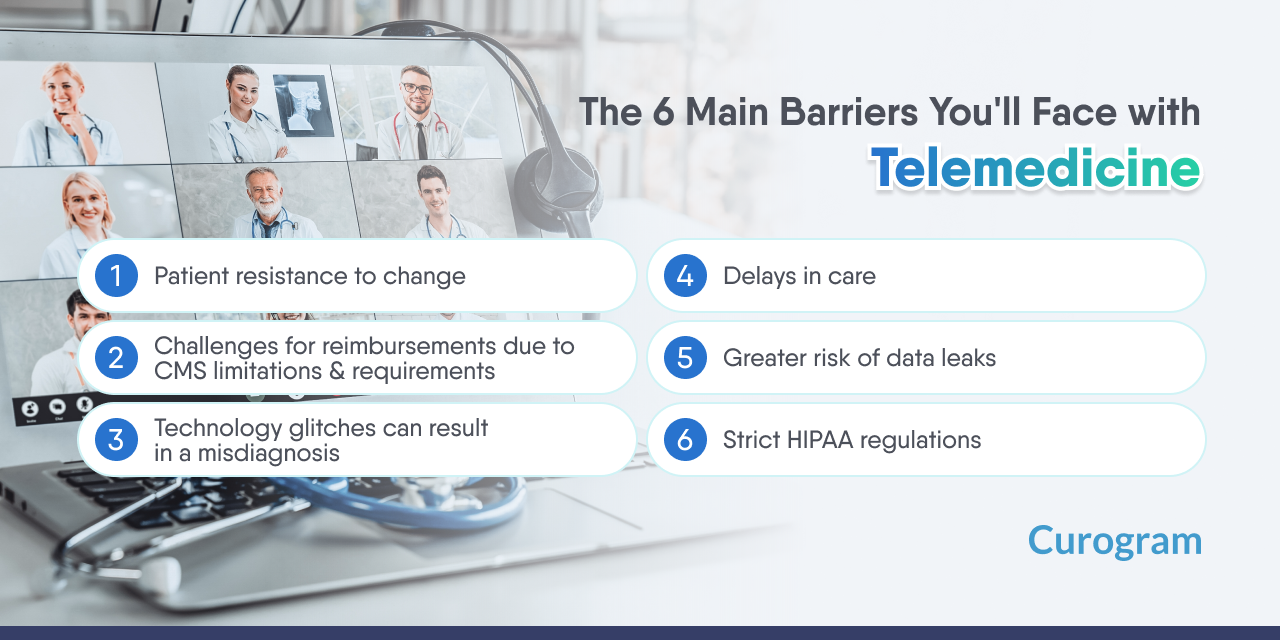How Does Telemedicine Work?
Originally, telemedicine's purpose was to provide primary care to patients from rural areas who needed medical attention but had limited access to...

Telemedicine originally started to provide healthcare to underserved patients who don’t have access to primary care because of their location, usually in rural areas. Although remote healthcare delivery has been around for years, its growth and expansion were slow and almost immovable as patients preferred face-to-face consultations.
However, recent events caused the rapid implementation of telehealth in all areas, from major cities to rural areas, and it proved efficient in providing quality care while minimizing physical interactions. Despite the many benefits of telemedicine amid a public health emergency, some barriers hinder the successful adoption and implementation of telehealth among healthcare providers and organizations.
The good news is you can overcome telemedicine barriers by learning about them and having an effective strategy. The following are some telemedicine concerns to consider and effective strategies for overcoming them.
A patient’s reluctance to receive care via telehealth can affect the overall result of remote healthcare delivery. As a medical practitioner, trying to keep up with innovations has become integral to remote healthcare delivery. But, no matter how well you and your team use the technologies to deliver services, patients’ comfort and self-confidence can differ when introduced to remote healthcare.
Many patients may not feel comfortable with technology and telehealth. Others may feel they can’t connect with a healthcare provider properly over a virtual visit. To overcome this barrier, it’s a good idea to gently introduce remote healthcare to your patients before implementing it into their care.
Take time to explain telemedicine, including why you use it and how it simplifies care. Give them detailed directions, and ensure staff are available for questions. Education and support are not stopped once you introduce telehealth to patients. Establish continuous communication to maintain your patients’ knowledge and keep them up-to-date with upgrades and the latest in remote care.
One of the main reasons for telemedicine’s slow development is the lack of legislative efforts to enact uniform coverage and reimbursement policies across state lines. Healthcare providers may find reimbursement for telehealth services problematic because of certain limitations and requirements the Centers for Medicare & Medicaid Services (CMS) implements.
Moreover, without a state parity law, reimbursement of telehealth services by private insurers is not mandatory. Many states are resolving the obstacles to reimbursing telehealth services by enacting laws to expand telemedicine coverage and reimbursement. For example, 27 states passed legislation enhancing Medicaid coverage for services delivered via telehealth. Additionally, 27 states have enacted state-level bills related to private insurance reimbursement for telehealth.
No matter how skilled and knowledgeable healthcare professionals are, medical mishaps and unintentional mistakes due to negligence or human error may happen. The same goes for telemedicine. Technology failures are possible since remote healthcare delivery significantly depends on telecommunications and the internet.
When a glitch in technology or the internet happens, a physician may find it hard to understand what the patient is saying during a telemedicine consultation, leading to a misdiagnosis. Missed diagnoses damage patients and healthcare providers because they could lead to inappropriate prescriptions and drive costs up.
This complex barrier requires a simple solution — double-checking. If you are unsure about what a patient just told you during a virtual visit due to a poor internet connection, ask again and clarify. Better yet, choose the live chat feature on the video conferencing app for more precise communication.
Without the internet, telemedicine isn’t possible. That is why if there is an interruption in remote healthcare delivery due to a weak internet connection, there is also a delay in care. For example, a physician wants to see the electronic health record (EHR) of a patient under the supervision of another medical professional as an additional source for initial treatment. But due to an interrupted internet connection, the former provider could not transfer the EHR at the time of the patient’s consult with the current provider, leading to delayed care and additional cost.
There isn’t much you can do to resolve a weak internet connection except to ensure you have a reliable internet provider or a backup internet source. If there is an interrupted internet connection in your area, inform your patients and avoid transferring sensitive data if you are doubtful that the other party will receive it on time.
When they learn about telemedicine, one of the significant concerns patients have is the privacy and confidentiality of their health data. The healthcare industry has always been a target for data breaches due to collecting and transferring large amounts of sensitive information.
Telemedicine poses an even greater risk of data-related incidents because it uses EHR and other electronic forms containing protected health information (PHI). So, when a technological failure happens in a telehealth platform that collects and transfers PHI, a data breach may occur.
Healthcare providers and organizations invest in telemedicine solutions with robust security, interoperability features, and encryption protocols that fully comply with HIPAA Privacy and Security rules to avoid data breaches.
Many healthcare professionals often forget the HIPAA regulations surrounding disclosing PHI over unsecured communication channels or with unauthorized individuals. That is why strict regulations remain one of the critical challenges in telemedicine.
Telemedicine platforms must be HIPAA-compliant to ensure the privacy and confidentiality of PHI when stored and transferred into systems. Although HIPAA compliance is a must, not all medical practices and institutions integrating telemedicine are HIPAA compliant by default.
HIPAA includes numerous rules and regulations that command healthcare providers to manage and disclose medical data properly. That is why some healthcare professionals and organizations may find complying with HIPAA requirements and policies too complicated and burdensome — hence, their reluctance to adopt telemedicine.
Healthcare providers who violate HIPAA regulations may pay $100 up to $50,000 per violation or face civil or criminal penalties. A breach can also cause irreparable damage to an organization’s reputation, leading to patients’ mistrust and disfavor.
A simple solution to this problem is implementing a HIPAA-compliant system such as Curogram, a telemedicine solution that fully complies with the HIPAA rules for data protection. Patients feel more relaxed, trusting, and motivated to carry out patient engagement over telehealth, knowing that their medical records and information are in your organization’s secured and HIPAA-compliant platform.
Now that you know the barriers to telemedicine and how to overcome them, you can secure the adoption of remote healthcare delivery in your practice and its many benefits.


Originally, telemedicine's purpose was to provide primary care to patients from rural areas who needed medical attention but had limited access to...

The state of New York is quite open to telemedicine. Governor Andrew Cuomo signed the New York telehealth parity law in 2014, and it went into effect...

The implementation of telehealth or telemedicine has expanded exponentially since the late 1990s. There’s never been a better time to offer remote...